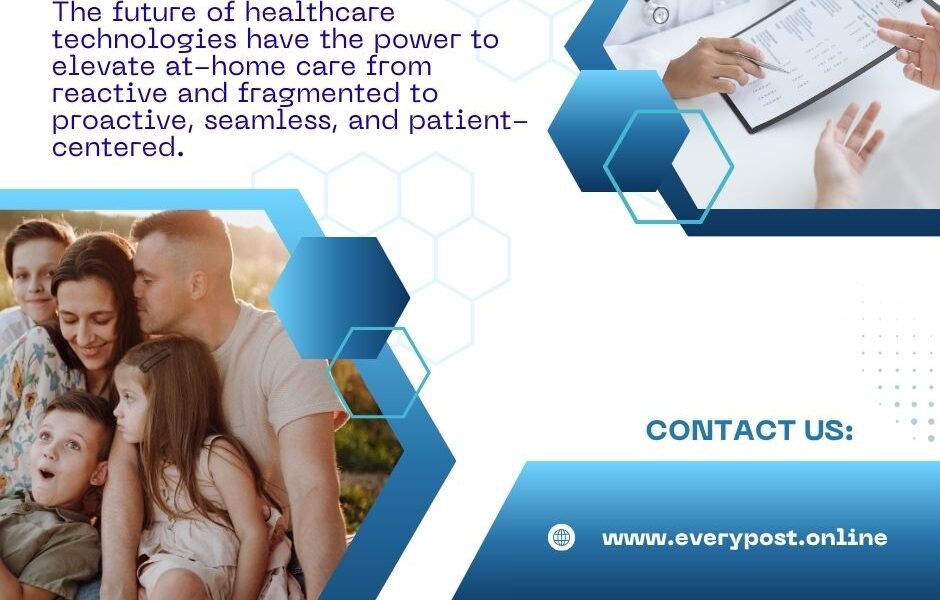In recent years, healthcare delivered in the home has grown from a niche convenience to a full-fledged transformation of care models. Enabled by new technologies, an aging population, and evolving patient expectations, “care at home” is being reimagined, not as a downgrade from hospital care, but as a sophisticated, patient-centric setting full of potential.
Every Post Online, as an informational website committed to publishing accurate and timely posts, is proud to spotlight how emerging healthcare innovations are enhancing safety, quality, and independence in home care.
The Drivers Behind the Shift to At-Home Care
Why is home care on the rise? There are several dynamics leading to this shift:
- Demographics: The world is getting older. Most seniors would prefer to “age in place” – that is, on their own rather than in an institution or facility.
- Cost: The hospital stay and institutional care are expensive. Health systems are being asked to reduce readmissions and to lower the overhead costs of hospital beds.
- Patient preference: Patients desire convenience and comfort, and better engagement and involvement in their care.
- Technology: Sensors, connectivity, AI, and remote monitoring make it feasible to deliver complex patient care in external spaces beyond brick walls.
- Health crises: During the COVID-19 pandemic we experienced an acceleration in the adoption of virtual or telehealth and the provision of remote care that was safe, effective, and scalable in large numbers.
Putting all of these dynamics together, technology can be the enabler of connecting patients’ home situations to professional-level care.
Key Technology Trends Elevating Home Care
1. Remote Patient Monitoring and Telehealth
One of the most obvious health care changes is remote patient monitoring (RPM). RPM encompasses devices that are constantly transmitting data to a clinician or repository (e.g., wearable sensors, home vital-sign monitors, smart scales, or a connected glucometer). The devices transmit ongoing data with health statistic(s) (e.g., heart rate, blood pressure, or oxygen levels) and can establish measurable trends to determine abnormal patterns compared to past baseline assessments.
Telehealth provides data with similar differences from in-person health care, either by video consultation, from remote check-ins, or actual telemedicine services. Telehealth facilitates patient engagements with a health care professional, efficiently, and while not in a clinic. The combination of RPM + telehealth creates an even larger hybrid model of care: Many routine visits will occur either on-line/video visits or asynchronous messaging.
Patients will perceive that in-office appointments will increasingly focus on episodic visits where in-person time is appropriately utilized for differences in urgency or procedure.
2. Artificial Intelligence, Analytics & Predictive Modeling
Raw sensor data can be used, but insights arise from the patterns generated and anomalous behaviors detected with the help of machine learning algorithms. AI and predictive analytics can detect early warning signs (e.g. mildly abnormal heart rhythms on ECG, small changes in weight that could indicate impending fluid overload in heart failure, or the risk of falling).
For example, some start-ups are now implementing AI-enabled ambient listening devices, which, absent video, analyze sounds in the home for reaction patterns indicative of agitation, confusion or behavior in the older adult. (Sensi.AI, a startup example of that application, just recently secured funding.)
By obtaining both AI and remote monitoring data, the system can triage alarms and provide proactive services, help reduce false alarms, and suggest some interventions (or escalate to human review).
3. Smart Home & Ambient Sensing
In addition to the wearables and monitors above, the “ambient home” of the future will feature unobtrusive sensors in utensils and infrastructure used every day. Examples might include:
- Motion sensors, pressure mats (i.e., under carpets or beds) to detect activity patterns
- Smart lighting, door sensors, voice assistants
- Smart toilets or hygiene systems that gather hydration information, determine infection risks, etc.
These passive technologies require little or no physical action on the part of the patient, making them preferable for elderly or frail individuals. Such ambient sensing can register departures from average behavior (e.g. fewer nighttime trips to the bathroom, altered gait) well in advance of a health crisis.
4. Robotics, Assistive Devices & Automation
Robotics in home health care, though still emerging, holds promise. Robots may assist with tasks like object retrieval, mobility support, medication delivery, or fall detection. Simultaneously, automated systems such as smart pill dispensers, reminders, robotic aids, or even semi-autonomous “social robots” (companions with basic conversational ability) may support daily living and adherence.
5. Virtual Wards and Hospital-at-Home Models
The concept of a virtual ward (or “hospital-at-home”) means delivering hospital-level care-monitoring, interventions, specialist oversight, in the patient’s home via technology.
Patients can be “admitted” to a virtual ward, receive daily remote assessments, and only require physical visits if necessary. This model reduces pressure on hospitals and allows earlier discharge.
6. Integrated Care Platforms & Coordination Tools
Historically, one of the chief barriers in caring for patients has been fragmentation. Devices, providers, caregivers, and health systems continue to operate in silos. The future is likely in coordinated care platforms that pull together data, coordinate caregivers, schedule visits, bill for visits, host virtual visits, and dashboards for clinicians, patients, and family members to view data.
For example, startups are working to automatically assist with back-office tasks in home health agencies (scheduling, billing, etc) by using AI-based tools to allow caregivers and clinicians to spend more time providing care and allowing for less paperwork burden.
Similarly, some health brands are developing logistics engines to facilitate caregiver routing for home visits, matching skills, costs, and scheduling.
7. Transitional Care & Post-Hospital Home Technology
Hospital-to-home transitions are a period of vulnerability and readmission risk. New care pathways incorporate IoT, AI, and digital assistants to ease that transition, monitor patients more closely, and reduce complications.
These systems can guide patients through wound care, medication adherence, vital sign checks, and identify early signs of possible deterioration during post-discharge recovery.
The Benefits of This Technological Elevation
When home care is augmented with these technologies, multiple gains follow:
- Earlier detection, fewer emergencies: Continuous monitoring and AI alerting allow issues to be addressed before they escalate.
- Reduced hospitalizations and readmissions: Patients stay in home as long as safe, reducing costs and exposure to hospital-based complications.
- Personalized, adaptive care: Treatment can be adjusted in near real-time based on actual patient data.
- Greater independence and dignity: Patients avoid institutionalization and retain control over their lives in a familiar environment.
- Cost-efficiency: Less dependence on expensive inpatient care or frequent clinician travel helps reduce system costs.
- Better resource use: Clinicians are guided by analytics and dashboards, improving workflow and allocation of human resources.
- Improved engagement: Patients and families become active participants, viewing health dashboards, receiving alerts, and communicating seamlessly with providers.
Challenges, Risks, and Ethical Considerations
The path isn’t without hurdles. Some of the main challenges include:
- Data privacy and security: Health data is sensitive. Protecting patient privacy in connected environments is critical.
- Interoperability: Devices from different manufacturers must share data in coherent standards.
- Alert fatigue and false positives: Too many alarms may overwhelm caregivers. Algorithms must be tuned carefully.
- Digital divide and accessibility: Not all patients have reliable connectivity, technical literacy, or infrastructure.
- Regulation, reimbursement, and policy: Health systems and payers must adapt to new care models (virtual care, remote monitoring, home-based reimbursement).
- Liability and accountability: If an AI misses an alert, who is responsible?
- Adoption, training, and change management: Clinicians and caregivers may resist new tools; training is essential.
- Upfront investment: The initial costs of deploying infrastructure, devices, and platforms can be high.
Still, as evidence accumulates and cost-benefit models become clearer, many of these obstacles are gradually being addressed.
What the Next Decade Might Look Like
Looking ahead, one can imagine:
- Homes fully embedded with passive sensors that unobtrusively monitor every aspect of health.
- AI assistants that converse naturally, ask health-check questions, and escalate issues autonomously.
- Seamless transitions between hospital and home, with “virtual wards” becoming routine.
- Health systems structured around value-based care, rewarding outcomes not volume, which favors preventive, home-based care.
- Greater integration between consumer devices (smartphones, wearables) and clinical systems.
- The metaverse or augmented reality guiding patients through rehabilitation exercises virtually in their homes.
- More equity in access as costs drop and infrastructure spreads, making advanced home care available well beyond wealthy regions.
Elevating Home Care, Elevating Lives
In conclusion, healthcare technologies of the future can transform at-home care from reactive and fragmented, to proactive and seamless, and patient-centered. The home shifts from a place of limitation, to a hub of connected care – where clinicians, caregivers, and patients co-navigate health journeys together.
Every Post Online is dedicated to continuing to provide you with timely and well-researched observations on such transformative trends. As home healthcare continues to evolve, we will continue to provide coverage on new innovations, success stories, pitfalls, and new models that move the needle.





